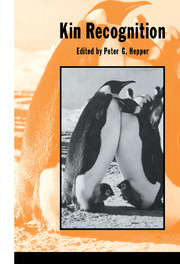Book contents
- Frontmatter
- Contents
- List of contributors
- Preface
- Introduction
- 1 The correlation between kinship and behaviour in non-human primates
- 2 Co-operation and reciprocity in birds and mammals
- 3 Kinship and fellowship in ants and social wasps
- 4 Successes and failures of parent–offspring recognition in animals
- 5 Kinship, kin discrimination and mate choice
- 6 Genetic components of kin recognition in mammals
- 7 Kin recognition in amphibians
- 8 Kin recognition cues of vertebrates
- 9 Recognizing kin: ontogeny and classification
- 10 Parental states as mechanisms for kinship recognition and deception about relatedness
- 11 Fetal learning: implications for the development of kin recognition
- 12 Information processing and storage during filial imprinting
- 13 The honey bee as a model kin recognition system
- 14 Mutual mother–infant recognition in humans
- Author index
- Species and common name index
- Subject index
Introduction
Published online by Cambridge University Press: 06 January 2010
- Frontmatter
- Contents
- List of contributors
- Preface
- Introduction
- 1 The correlation between kinship and behaviour in non-human primates
- 2 Co-operation and reciprocity in birds and mammals
- 3 Kinship and fellowship in ants and social wasps
- 4 Successes and failures of parent–offspring recognition in animals
- 5 Kinship, kin discrimination and mate choice
- 6 Genetic components of kin recognition in mammals
- 7 Kin recognition in amphibians
- 8 Kin recognition cues of vertebrates
- 9 Recognizing kin: ontogeny and classification
- 10 Parental states as mechanisms for kinship recognition and deception about relatedness
- 11 Fetal learning: implications for the development of kin recognition
- 12 Information processing and storage during filial imprinting
- 13 The honey bee as a model kin recognition system
- 14 Mutual mother–infant recognition in humans
- Author index
- Species and common name index
- Subject index
Summary
The importance of kinship for human societies has long been recognized, indeed the interest in kinship is reflected in the large number of works, plays, books, operas, etc., which have kinship, often mistaken, as their central theme. Whilst there has been little doubt that humans recognize their kin and respond differentially to them, the ability of animals to recognize and respond differentially to kin has received little attention. In recent years, however, study of the influence of kinship on the social behaviour of animals has increased dramatically. Much of the impetus for this research can be attributed to the seminal works of Hamilton (1964a,b) and later Wilson (1975). Evidence that kinship, or genetic relatedness, influences an individual's behaviour has now been documented in all the major groups of animals – from single-celled organisms (e.g. Grosberg & Quinn, 1986) to man (e.g. see Porter, this volume). Reptiles remain an exception to this and only recently have studies appeared providing evidence of kin recognition in this group (e.g. Werner et al, 1987), which probably reflects a lack of empirical investigation rather than a lack of ability to recognize kin. As diverse as the groups of animals which exhibit evidence of kin recognition are the behaviours in which individuals respond differentially on the basis of kinship; colonization patterns, mating, play, aggression, feeding, schooling, swarming, defence, etc. all are influenced by kinship. Investigations of the ability to recognize kin have revealed that individuals have well developed capabilities to recognize kin; siblings, half-siblings, cousins, parents, offspring, grandparents, aunts and uncles are all capable of being discriminated. Kinship thus appears to influence behaviour throughout the animal kingdom.
- Type
- Chapter
- Information
- Kin Recognition , pp. 1 - 5Publisher: Cambridge University PressPrint publication year: 1991
- 1
- Cited by



